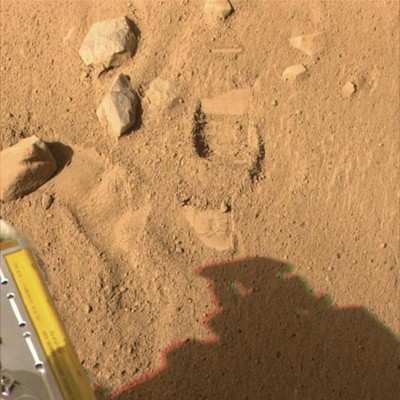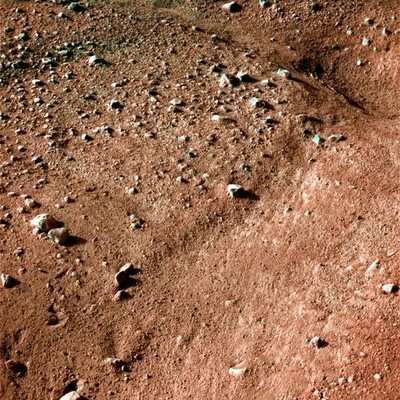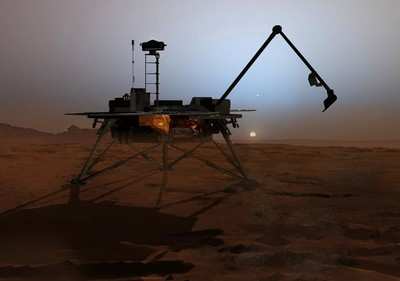First Such Studies Since Viking Missions Of 1970s
New observations from NASA's Phoenix Mars Lander provide the
most magnified view ever seen of Martian soil, showing particles
clumping together even at the smallest visible scale. In the past
two days, two instruments on the lander deck -- a microscope and a
bake-and-sniff analyzer -- have begun inspecting soil samples
delivered by the scoop on Phoenix's Robotic Arm.

"This is the first time since the Viking missions three decades
ago that a sample is being studied inside an instrument on Mars,"
said Phoenix Principal Investigator Peter Smith of the University
of Arizona, Tucson.
Stickiness of the soil at the Phoenix site has presented
challenges for delivering samples, but also presents scientific
opportunities. "Understanding the soil is a major goal of this
mission and the soil is a bit different than we expected," Smith
said. "There could be real discoveries to come as we analyze this
soil with our various instruments. We have just the right
instruments for the job."
Images from Phoenix's Optical Microscope show nearly 1,000
separate soil particles, down to sizes smaller than one-tenth the
diameter of a human hair. At least four distinct minerals are
seen.

"It's been more than 11 years since we had the idea to send a
microscope to Mars and I'm absolutely gobsmacked that we're now
looking at the soil of Mars at a resolution that has never been
seen before," said Tom Pike of Imperial College London. He is a
Phoenix co-investigator working on the lander's Microscopy,
Electrochemistry and Conductivity Analyzer.
The sample includes some larger, black, glassy particles as well
as smaller reddish ones. "We may be looking at a history of the
soil," said Pike. "It appears that original particles of volcanic
glass have weathered down to smaller particles with higher
concentration of iron."
The fine particles in the soil sample closely resemble particles
of airborne dust examined earlier by the microscope.
Atmospheric dust at the Phoenix site has remained about the same
day-to-day so far, said Phoenix co-investigator and atmospheric
scientist Nilton Renno of the University of Michigan, Ann
Arbor.

"We've seen no major dust clouds at the landing site during the
mission so far," Renno said. "That's not a surprise because we
landed when dust activity is at a minimum. But we expect to see big
dust storms at the end of the mission. Some of us will be very
excited to see some of those dust storms reach the lander."
Studying dust on Mars helps scientists understand atmospheric
dust on Earth, which is important because dust is a significant
factor in global climate change.
"We've learned there is well-mixed dust in the Martian
atmosphere, much more mixed than on Earth, and that's a surprise,"
Renno said. Rather than particles settling into dust layers, strong
turbulence mixes them uniformly from the surface to a few
kilometers above the surface.
Scientists spoke at a news briefing today at the University of
Arizona, where new color views of the spacecraft's surroundings
were shown.

"We are taking a high-quality, 360-degree look at all of Mars
that we can see from our landing site in color and stereo," said
Mark Lemmon, Surface Stereo Imager lead from Texas A&M
University, College Station.
"These images are important to provide the context of where the
lander is on the surface. The panorama also allows us to look
beyond our workspace to see how the polygon structures connect with
the rest of the area. We can identify interesting things beyond our
reach and then use the camera's filters to investigate their
properties from afar."
 OSH25 Day Four Redux: Spirit SE-1!, H55 eFlyer, King Schools
OSH25 Day Four Redux: Spirit SE-1!, H55 eFlyer, King Schools ANN Thanks Our Speedy Sponsor... Blackshape!!!
ANN Thanks Our Speedy Sponsor... Blackshape!!! Alpha Systems AOA Guides ANN Oshkosh Coverage
Alpha Systems AOA Guides ANN Oshkosh Coverage Pilot Mall Intro's High Flying Models To ANN Sponsor Lineup
Pilot Mall Intro's High Flying Models To ANN Sponsor Lineup CiES Fuels ANN's Oshkosh 2025 Special Event Coverage
CiES Fuels ANN's Oshkosh 2025 Special Event Coverage






